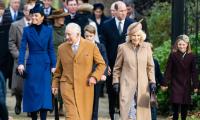SHANGHAI: A groundbreaking remote robot-assisted lung cancer surgery spanning over 5,000 kilometers was successfully completed at the Second People’s Hospital of Kashgar in Northwest China’s Xinjiang region in collaboration with the Shanghai Chest Hospital the other day, foreign media reported.
This surgery marks a significant milestone in the advancement of domestic robotic thoracic surgery technology, breaking through spatial and geographical limitations and allowing more patients to benefit from China’s “smart” advantages, according to Kashgar local media.
The surgery was led by Professor Luo Qingquan, a renowned expert in robotic thoracic surgery from the Shanghai Chest Hospital, with a team of assistants led by Chen Tianxiang, vice president of Second People’s Hospital of Kashgar, who is also on staff at the Shanghai Chest Hospital to support Xinjiang.
Utilising the high-speed and low-latency characteristics of the 5G network, the expert team from the Shanghai Chest Hospital remotely controlled a domestic 5G remote surgical robot in Kashgar, successfully removing a lung tumor from a local patient.
“The success of the operation demonstrates that our domestic robotic surgery technology in thoracic surgery has further overcome spatial limitations,” said Luo Qingquan, the lead surgeon.
“With this technology, patients in remote areas can access top-tier medical services without traveling to big cities.” The surgical robots were developed by Shanghai MicroPort MedBot (Group) Co. The patient, a middle-aged woman, had a growing lump in her right lung that was identified three years ago. Luo and his team deemed her a suitable candidate for remote robotic surgery after reviewing her medical records.
A preoperative consultation via video linkup between Shanghai Chest Hospital and Kashgar Prefecture No 2 People’s Hospital, where the woman was admitted, allowed doctors to discuss the preparations and the surgical plan in detail.
The surgery lasted an hour and proceeded smoothly. Luo manipulated the robotic arms in Shanghai, transmitting real-time instructions to the robotic arms in Kashgar, which precisely mirrored his movements to dissect, separate, cut and suture.
“I felt as though I was literally operating the robotic arms on-site in Kashgar. It was perfectly simultaneous,” Luo said. Chen Tianxiang, a chest surgeon from Shanghai Chest Hospital currently assisting at the Kashgar hospital, led a team in the operating room for real-time discussion and coordination with the Shanghai team.
“Robotic surgery is one of the most advanced minimally invasive technologies, offering patients higher accuracy, smaller wounds and faster recovery,” Luo said. Robots enhance the surgeon’s field of vision 10 to 15 times with three-dimensional, high-definition images, and their arms filter out human hand tremors for improved precision.
During the surgery, Professor Luo operated the robot from the surgical console at the Shanghai hospital, using a 3D display screen and a master controller to see real-time images of the patient’s chest cavity and precisely manipulate the robot arm for the operation.
Shanghai Chest Hospital was the first medical institution on the Chinese mainland to carry out robot-assisted chest surgeries. It was also the first hospital in the country to perform more than 1,000 chest surgeries assisted by surgical robots a year.
Justice Abdul Shakoor Paracha fixes hearing on December 24 regarding Islamabad constituencies
Police made one arrest after vehicle drove “at least 400 metres across the Christmas market”
Incident occurred when couple, along with their child, was travelling in their car
Congress party dismisses incident as political gimmick
"I am sure once negotiations start, things will move forward," says NA speaker
Discussion focuses on enhancing governance, accountability and functional autonomy within police







